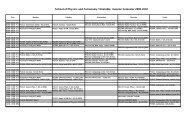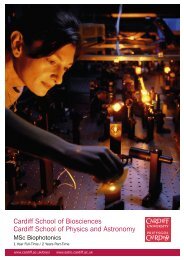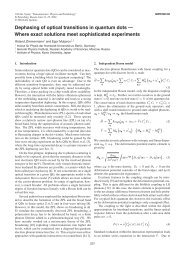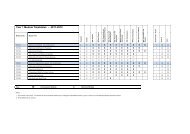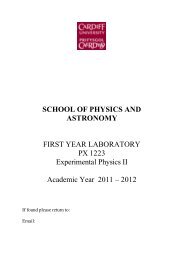PX1121 MECHANICS AND MATTER - Cardiff School of Physics and ...
PX1121 MECHANICS AND MATTER - Cardiff School of Physics and ...
PX1121 MECHANICS AND MATTER - Cardiff School of Physics and ...
Create successful ePaper yourself
Turn your PDF publications into a flip-book with our unique Google optimized e-Paper software.
PX1226 HOW THE HUMAN BODY WORKS<br />
MODULE INFORMATION:<br />
Spring semester: 10 credits.<br />
Module organiser: Dr N D Pugh.<br />
Deputy Module Organiser: Dr R J Morris.<br />
Teaching <strong>and</strong> feedback methods: Lectures 22 x 1 hr, exercises.<br />
Assessment: Examination 80%. Coursework 20%. [Examination duration: 2 hours]<br />
Pre-cursors: None.<br />
Co-requisites: None.<br />
Pre-requisites: None.<br />
AIMS OF THE MODULE:<br />
To provide to students <strong>of</strong> physics an introduction to human anatomy <strong>and</strong> physiology.<br />
To give an overview <strong>of</strong> the construction <strong>and</strong> function <strong>of</strong> cells, <strong>and</strong> the structure <strong>and</strong> operation <strong>of</strong> the musculoskeletal,<br />
nervous, cardiovascular, digestive <strong>and</strong> reproductive systems.<br />
To give a working knowledge <strong>of</strong> genetics <strong>and</strong> the basis <strong>of</strong> inheritance, infection <strong>and</strong> disease control.<br />
LEARNING OUTCOMES:<br />
The student will be able to:<br />
Describe the structure <strong>and</strong> function <strong>of</strong> cells <strong>and</strong> processes such as osmosis, diffusion <strong>and</strong> active transport.<br />
Explain the concepts <strong>and</strong> mechanisms <strong>of</strong> inheritance.<br />
Outline the structure <strong>and</strong> role <strong>of</strong> the musculoskeletal system.<br />
Identify key features <strong>and</strong> mechanisms <strong>of</strong> nerve cells, the nervous system <strong>and</strong> sensory perception.<br />
Describe the role <strong>of</strong> the cardiovascular system, the composition <strong>and</strong> transport <strong>of</strong> blood, <strong>and</strong> the functions <strong>of</strong> respiration.<br />
Explain the functions <strong>of</strong> the digestive <strong>and</strong> renal systems.<br />
Describe the human reproductive system, including the hormonal controls <strong>of</strong> ovarian <strong>and</strong> male reproductive function.<br />
OUTLINE SYLLABUS:<br />
Cells: Cell structure <strong>and</strong> function, DNA, proteins, carbohydrates. Cell membrane, osmosis, diffusion, active transport. Genetics,<br />
mitosis, meiosis. Inheritance, monohybrid inheritance, co-dominance, sex determination, sex linkage.<br />
Musculoskeletal System: Bone <strong>and</strong> skeletal system. Types <strong>of</strong> bone, joints. Muscles, types <strong>of</strong> muscle, mechanics <strong>of</strong> muscle<br />
contraction <strong>and</strong> joint movement.<br />
Nervous <strong>and</strong> Control Systems: Nerve cell, neuromuscular transmission, central nervous system, peripheral nervous system, sensory<br />
functions, motor functions. Endocrine system.<br />
Cardiovascular system: Blood <strong>and</strong> constituents, blood groups, heart structure <strong>and</strong> function, blood pressure, blood vessels,<br />
lymphatics <strong>and</strong> lymph, diseases <strong>of</strong> cardiovascular system. Structure <strong>of</strong> respiratory system, respiration, functions <strong>of</strong> respiration,<br />
transport <strong>of</strong> oxygen <strong>and</strong> carbon dioxide, oxygen dissociation curve, maintenance <strong>of</strong> blood pH.<br />
Urinary system: Kidney structure <strong>and</strong> function, water balance regulation.<br />
Digestive system: Structure, food <strong>and</strong> nutrition, energy balance, homeostasis.<br />
Reproductive system: Anatomy <strong>of</strong> the male reproductive system, spermatogenesis, hormonal control <strong>of</strong> male reproductive<br />
functions. Anatomy <strong>of</strong> the female reproductive system, ovarian function, control <strong>of</strong> ovarian function.<br />
TRANSFERABLE SKILLS:<br />
Problem solving. Investigative skills. Mathematics. Analytical skills.<br />
READING LIST:<br />
Any general anatomy <strong>and</strong> physiology textbook.<br />
NOTES:<br />
This module can be <strong>of</strong>fered as a FSM.



